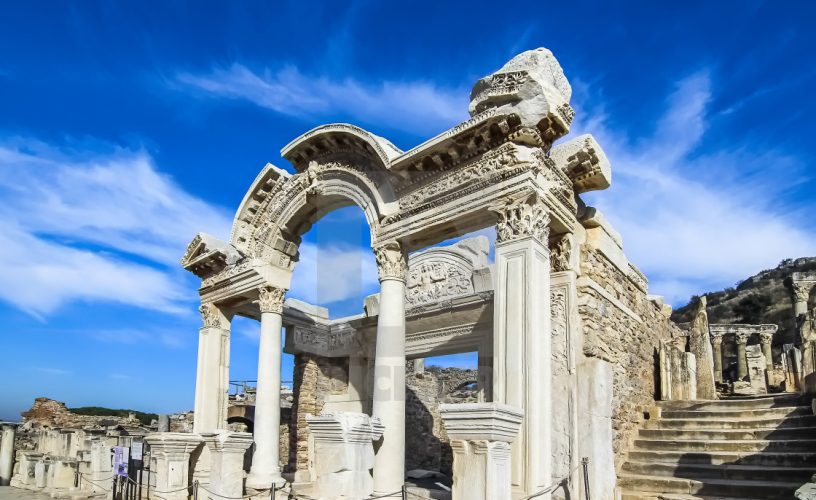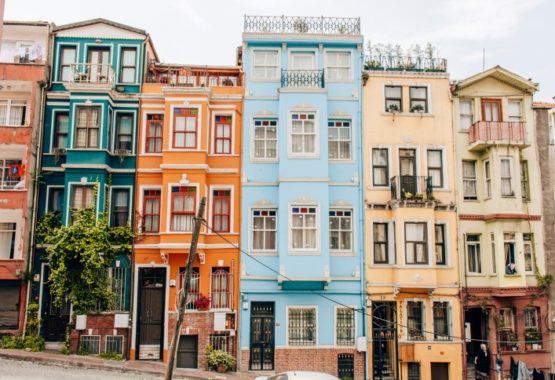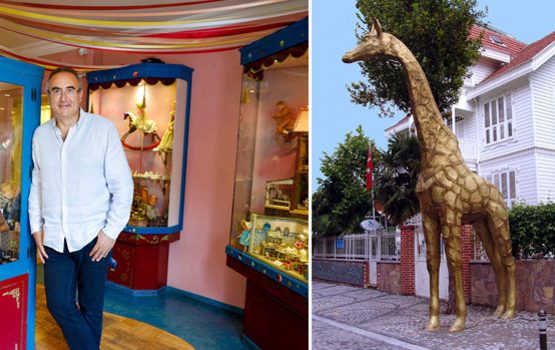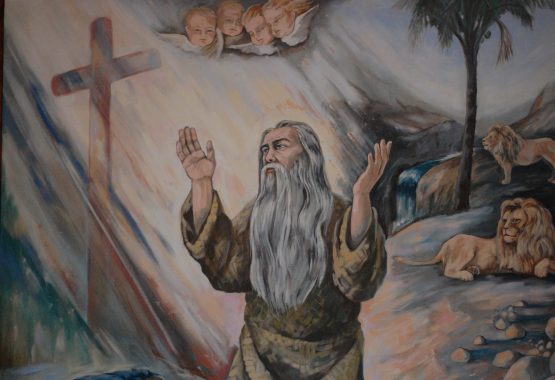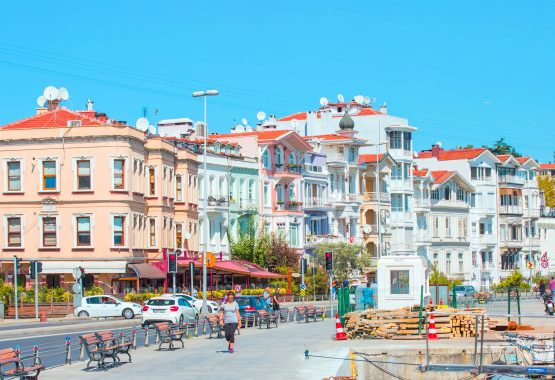Church in Ephesus
Ephesus was an ancient Greek city on the coast of Ionia, three kilometres southwest of available-day Selçuk in İzmir Province, Turkey. It was built in the 10th century BC on the site of the old Arzawan capital by Attic and Ionian Greek colonists. During the Classical Greek era it was one of the twelve cities of the Ionian League. The city flourished after it came under the control of the Roman Republic in 129 BC.
The word Ephesus means desirable, and in many ways it was certainly a desirable place to live. In the ancient world, Ephesus was a center of travel and trade. Situated on the Aegean Sea at the mouth of the Cayster River, the city was one of the greatest ports of the ancient world.
The city was famed for the nearby Temple of Artemis (completed around 550 BC), one of the Seven Wonders of the Ancient World. Among many other monumental buildings are the Library of Celsus, and a theatre capable of holding 25,000 spectators.
Ephesos was one of the seven churches of Asia that are cited in the Book of Revelation. The Gospel of John may have been written here. The city was the site of several 5th-century Christian Councils (see Council of Ephesus).
The church in Ephesus (2:17) was commended for its hard work and perseverance. The church encountered much spiritual opposition from the temple of Artemis as well as from the fourteen or more other Greek deities that were worshipped.
Ephesus was also a center of magical practices. False apostles in the church were also a problem. At Miletos St. Paul had warned the Ephesians elders that some from their own company would distort the truth. Timothy was to make the Ephesians Hymenaeus, Alexander, and Philetus stop teaching false doctrine.
The city was destroyed by the Goths in 263, and although rebuilt, the city’s importance as a commercial centre declined as the harbour was slowly silted up by the Küçükmenderes River. It was partially destroyed by an earthquake in AD 614.
Church in Smyrna
Similar to Ephesus, which was only 40 miles to the south, Smyrna had many visitors. Boasting an excellent harbor and the beginning of a well-traveled road to the interior, Smyrna regularly had travelers passing through it. This great trading city, founded by Alexander the Great, continues to this day as the modern Turkish city of Izmir with a population of approximately 2.8 million.
Smyrna was known for its schools of science and medicine. It boasted of, on the slope of Mount Pagus, a theater that could seat up to 20,000 audience. The city also famous Olympian games that were very popular with the local populace.
In 197 B.C., after Smyrna severed its relationship with the Pergamos ruler King Eumenes, it asked the Roman Empire for aid. The people of the city, because they had never established any connection to the Roman Empire, sought to create a bond by creating a Roman based cult. The ‘Rome cult’ of Smyrna soon spread to other locations and may have led to the worship of the pagan goddess Roma.
On the ground floor of the marketplace (Agora) in Smyrna existed twenty-eight businesses, all of which faced against the north. The market’s second floor contained rows of columns between which galleries existed. As such, the Agora was the largest marketplace in the ancient world.
Church in Pergamum
The ruins of Pergamum sit atop a hill overlooking the modern-day city of Bergama. A state-of-the-art cable car carried us to the top of the hill where we viewed extensively excavated ruins. Pergamum was a principal city of the Roman Empire in the first century. The most striking remnant is the steep theater built into the side of the hill that seated 10,000 people.
But it was the ruins of the temple to Zeus that sobered me. Jesus had some serious warnings toward Christians in Pergamum who had fallen away from His teaching to embrace sinful behaviors. Scholars like to discussion the reasons for Jesus’ warning to the church at Pergamum in the Book of Revelation. It’s full of cryptic references to the “throne of Satan” and the teachings of the “Nicolaitans.” If they did not repent, Jesus Himself would come and fight against them. Jesus did, however, commend the few in Pergamum who stood strong and didn’t renounce their faith even when their friend Antipas was killed (Revelation 2:13).
This Acropolis is filled with temples. Built in honor of Athena, Dionysus, and the Roman Emperor Trajan, these places of worship established the city’s reputation throughout the empire as a spiritual place. Pergamum was home to a important number of Christians as well, and although they had not refuse Christ, Jesus says that they had allowed themselves to be influenced by paganism, idolatry, and false teachings.
I preached from Revelation 2:12-17 in the center of the steep 10,000-seat Hellenistic Theater. In the middle of my sermon (beginning at about 2:23), you can hear the Islamic call to prayer ringing out from mosques in various neighborhoods of the town below. It was a astonishing irony: gospel preaching in a place that was once filled with Christ-followers, but is now 99% Muslim, about the dangers of compromise with pagan philosophies.
In the end, I believe that Jesus mentions the church at Pergamum in Revelation because the believers there faced a similar spiritual climate to what we face today. As we explored the beautiful ruins of ancient Pergamum, it occurred to us that we were, in a sense, viewing one possible future for the church in America. Our only hope against evil and deceit is to hold tightly to the gospel of Christ; to know the Word of God and to hold every practice, philosophy, and teaching to its standard.
Church in Thyatira
It was an ancient Greek city called “Pelopia, and during the Hellenistic era, in 290 BC, it was named Thyateira (Θυάτειρα) by King Seleucus I Nicator. He was at war with Lysimachus when he learned that his wife had given birth to a daughter. According to Stephanus of Byzantium, he called this city “Thuateira” , meaning “daughter”, although it is likely that it is an older, Lydian name. In classical times, Thyatira stood on the border between Lydia and Mysia.
A Macedonian colony was established in Thyatria (Strabo, XIII, 4). The Greek deities especially worshipped in Thyatria including Asclepias, Dionysus, Artemis, and above all Apollo, in whose honor athletic games were instituted.
Thyatira became an early center of Christianity. The apostle Paul visited the city on a number of occasions during his missionary travels. Lydia, the woman converted by St. Paul at Philippi, was from Thyatira (Acts 16:13-15), and the church at Thyatira was one of the Seven Churches of Revelation (Rev. 2:18-29).
The Emperor Vespasian began great undertakings at Thyatira; it was also visited by Hadrian in the year 123, and by Caracalla in 215.
We know from testimony given by St. Epiphanius that at the beginning of the third century almost all Thyatira was Christianized. A bishop of Thyatira attended the Council of Nicea in 325 and the Council of Ephesus in 431.
The bishopric of Thyatira was subject to that of Sardis as late as the 10th century; it is not known when it disappeared. In the Middle Ages the Turks changed the name of Thyatira to that of Ak-Hissar (the White Fortress), which it still bears.
His Revelation to John, Jesus condemns the church in Thyatira for tolerating sexual sin. A woman had introduced false teaching that glorified immorality and led people astray. This was serious business. Those who participated in this deceit, the Lord said, would be “shattered like pottery.”
Thyatira was famous for indigo, the deep blue dye that was applied to wool and linen. In Acts 16, we read about the conversion of Lydia, a women from Thyatira who was a dealer of “purple cloth” in Philippi. It stood on the border of the regions of Lydia and Mysia, where Paul was prevented by the Holy Spirit from entering Bythinia. Today, it’s a small but densely-populated modern city.
Church in Sardis
Sart, or which is called Sardis by Lydians, was the capital of a state with major economic and political power in the 6th and 7th centuries BC; that is, the Lydian state. In fact, it is thought that a significant part of the wealth of Lydian people, who used money for the first time, came from gold mines located in the vicinity of Paktalos River, which is called Sart Stream today.
The ruins of the ancient city of Sardis are located today, within the boundaries of Salihli District which is 62 km away from Manisa Province. The ancient city of Sardis contains many historical values from Lydians and Romans, under the rule of which it has gotten after Lydians.
The Temple of Artemis, one of Anatolia’s seven temples and Sardis Synagogue, which one of the most impotant evidences of the Jewish presence in Western Anatolia in ancient times, which are located in historical conservation area are quite prominent and unique cultural artifacts in respect of ruins of Bath-Gymnasium Complex of the Roman period.
Many typical mausoleums of the ancient age, which are called tumulus and located in Bintepeler territory near Sart which is thought to be the acropolis of Sardis Ancient City, are in this region as an ancient memory of the rich and glorious history of Lydians.
Authors in ancient times, too, interpret on the natural and ecological wonders of the area. Those who traveled along the Royal Road to the famous courts and palaces of the East passed by Sardis. Homer and, later, Strabo tell of the importance of the Gygaean Lake from an ecological perspective as well as a spiritual one. According to Homer, the lake represented the ancestral home of Lydians: “Son of Otrynteus, most feared of men, there you lie. Your death is here, though your birth was by the Gygaean Lake where is your ancestral estate close by the Hyllus rich in fish and the eddying Hermus.”3 With the Gygaean Lake as mother of the region, dependent to the cult of Kybele ( herself linked to mountains and waters),4 central Lydia offers unprecedented potential for building a heritage program that draws on rich oral traditions to situate the current, bustling urban and rural landscapes of today within the historical memories of the region.
Church in Philadelphia
It stands on elevated ground commanding the extensive and fertile plain of the Gediz River (Hermus in antiquity), presenting an imposing appearance when seen from a distance. There are small industries and a fair trade. From one of the mineral springs comes a heavily charged water popular around Turkey.
Within Turkey, the city’s name is synonymous with the dried Sultana raisins, although cultivation for the fresh fruit market, less labour-intensive than the dried fruit, has gained prominence in recent decades. As Philadelphia, Alaşehir was a highly important center in the Early Christian and Byzantine periods. It remained a strong center of Orthodox Christianity until the early 20th century, and remains a titular see of the Roman Catholic Church.
Philadelphia (modern Alashehir) was founded in the third century B.C. by one of the Pergamenian kings and named after Attalus II (159–138 B.C.) who, in spite of Roman pressure, maintained “loyalty/love” for his brother, Eumenes II (197–159 B.C.)— thus the name “Philadelphia” (brotherly love). East of Smyrna (Izmir) in western Turkey. In New Testament times it was at an important junction of one of the greatest highways in the world which led the East to the West, terminating at Smyrna; and a diagonal route that ran from Pergamum 111 mi. [178 km.] to the northwest to Attalia. It was the youngest of the seven cities.
In ancient sources, Philadelphia was known for housing a number of temples and in A.D. 17 it was destroyed by a devastating earthquake. In Revelation 3:12, the believer who “overcomes” is compared to a pillar (stability) in the temple of God, and on him/it three names will be written — compare the names inscribed on the columns of the temple of Zeus at Euromos.
The city of Philadelphia was also known for its beautiful buildings and architecture. Because of its volcanic fertile soil, there were many grape vineyards. Thus it was the center of the worship of the Greek god Dionysius, the god of wine. The city was backed by volcanic cliffs and though the land was rich and fertile from the volcanic residue. It was a dangerous place to live due the many earthquakes experienced by the region.
As the sixth church of revelation, the letter acknowledged that followers were persecuted by jews. Like Smyrna, Saint john was full of praise for their devotion.
Church in Laodikeia
Laodikeia was one of the cities of Anatolia in the 1st century BC. The ancient city of Laodicea, located 6 km north of Denizli, is located at a very convenient point in the geography and south of the Lykos river. The name of the city is mostly referred to as “Laodikeia on the coast of Lykos”.
Church of Laodikeia was identified in 2010 and completely excavated the same year. It was built during the reign of Constantine the Great, when he declared that Christianity was allowed in AD 313.
Laodicea on the Lycus, located at the junction of important trade routes, was once a prosperous city, famous for its black wool, banking apparatus, and medical achievements. In the times of late antiquity, it had a large Jewish community and a important congregation of Christians. St. John mentioned Laodicea as one of the Seven Churches of Asia in the Book of Revelation
Excavations here have revealed artifacts dating from 3500 BC (Late Chalcolithic) to 3000 BC (Early Bronze Age). The city’s name comes from the Seleucid king Antiochus ii, who named it for his wife Laodike in the 3rd century BC when it wa thriving. Later controlled by the kings of Pergamum, it was willed to the Roman Empire, and thrived again from the 4th to 6th centuries. Its importance then numbered it among the Seven Churches of Revelation.
Set in an earthquake zone, it was ruined and restored many times, but by the early 1200s it was only farmer’s fields.
Laodicea regains some of its former glory…
Archeological and restoration work is still very much under way at Laodicea, and will be for years—perhaps decades—to come. But there’s enough to see right now to repay a visit.
As mentioned, Laodicea is spread over 5 sq km (2 sq mi), most of it unexcavated and unrestored, but you can visit the restored parts in as little as 30 minutes, or as much as 2 hours. Audio guides are available for rent, and display signs mark the most important sites.

